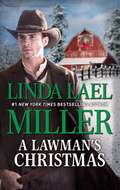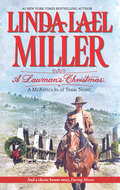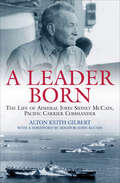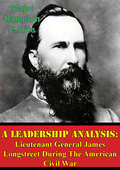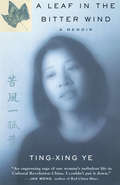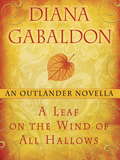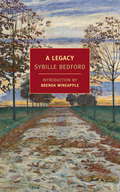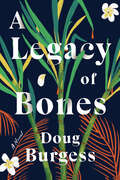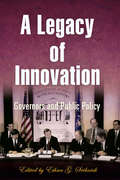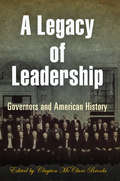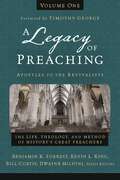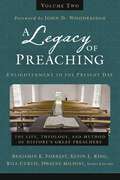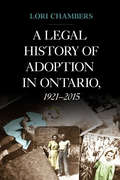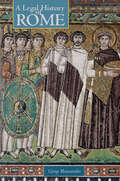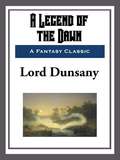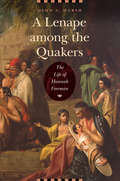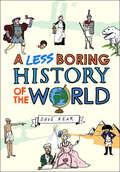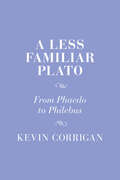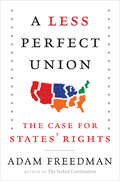- Table View
- List View
A Lawman's Christmas: A Lawman's Christmas An Outlaw's Christmas (McKettricks of Texas #14)
by Linda Lael MillerLove will give her hope in the darkest of times… Don’t miss this reader favorite McKettrick tale from #1 New York Times bestselling author Linda Lael Miller.The sudden death of the town marshal leaves Blue River, Texas, without a lawman…and twenty-five-year-old Dara Rose Nolan without a husband. As winter approaches and her meager seamstress income dwindles, she has limited options, none of them appealing. Unfortunately she must decide—soon—because there’s a new marshal in town, and she’s living under his roof.With the heart of a cowboy, Clay McKettrick plans to start a ranch and finally settle down. He isn’t interested in uprooting Dara Rose and her children, but he is interested in giving her protection, friendship—and passion. And when they say “I do” to a marriage of convenience, the temporary lawman’s Christmas wish is to make Dara Rose his permanent wife…. Originally published in 2011
A Lawman's Christmas: A McKettricks of Texas Novel
by Linda Lael MillerThe sudden death of the town marshal leaves Blue River, Texas, without a lawman...and twenty-five-year-old Dara Rose Nolan without a husband. As winter approaches and her meager seamstress income dwindles, she has three options. Yet she won't give up her two young daughters, refuses to join the fallen women of the Bitter Gulch Saloon and can't fathom condemning herself to another loveless marriage. Unfortunately she must decide-soon-because there's a new marshal in town, and she's living under his roof.With the heart of a cowboy, Clay McKettrick plans to start a ranch and finally settle down. He isn't interested in uprooting Dara Rose and her children, but he is interested in giving her protection, friendship-and passion. And when they say "I do" to a marriage of convenience, the temporary lawman's Christmas wish is to make Dara Rose his permanent wife....
A Leader Born: The Life of Admiral John Sidney McCain, Pacific Carrier Commander
by Alton Keith GilbertThis biography of one of World War II’s great military leaders is a “rich tribute to a staunch American naval hero” (WWII Quarterly).John S. “Slew” McCain was an old-school sailor. Wiry, profane, a cusser, and a gambler, he reminded more than one observer of Popeye. He was also a pioneer in the hard-hitting naval tactics that brought Imperial Japan to its knees.McCain graduated from Annapolis in 1906 and served aboard an armored cruiser in World War I. Perceiving the future of naval warfare, he earned his aviation wings in 1936, and by 1939, McCain was commander of the aircraft carrier USS Ranger. He was thus well-placed to play a leading role in America’s cut-and-thrust war with the Japanese across the broad expanses of the Pacific. In 1942, he was made commander of all land-based aircraft during the campaign for Guadalcanal. Though he took his share of blame for the disaster at Savo Island, he counterattacked with every means at his disposal, to the point of commandeering the planes of the crippled carriers Enterprise and Saratoga to reinforce US strength on Henderson Field.By the time the US returned to the Philippines, McCain was leading a fast carrier task force under William “Bull” Halsey. When asked what he thought about his carrier commander, Halsey replied, “Not much more than my right arm.” McCain’s carrier group would destroy thousands of enemy planes and hundreds of ships with aggressive swarming tactics. Four days after Japan officially surrendered, McCain died in his bed. His name has lived on, however, through his son, who became commander of US naval forces in the Pacific, and his grandson, John S. McCain III, carrier pilot, Vietnam POW, and United States Senator.Drawing upon a wealth of primary sources, including information provided by the McCain family, as well as an expert grasp of the titanic battles waged by the US armed forces in the Pacific, Alton Keith Gilbert has provided the fullest account of the Admiral John McCain’s life yet written.
A Leadership Analysis: Lieutenant General James Longstreet During The American Civil War
by Major Hampton E. HiteThis thesis is a chronological analysis of Longstreet during the thirteen major campaigns in which he participated: First Manassas, Williamsburg, Seven Pines, the Seven Days, Second Manassas, Antietam, Fredericksburg, Suffolk, Gettysburg, Chickamauga, Knoxville, the Wilderness, and Petersburg. The primary thesis question is: Was Longstreet's leadership during the war satisfactory when analyzed in the context of the nine leadership competencies of FM 22-100, Military Leadership?The nine leadership competencies are the result of a 1976 study group consisting of army leaders ranking from Corporal to General. The nine competencies are: supervision, soldier/team development, technical and tactical proficiency, use of available systems, professional ethics, planning, decision making, teaching and counseling, and communications.After a discussion of each campaign an analysis of Longstreet's leadership is conducted using the leadership competencies as analytical criteria. A leadership profile of Longstreet evolves as he gains experience during the war and is assigned to positions of increased responsibility.The conclusion of this thesis is that Longstreet's leadership was satisfactory during the war when analyzed in the context of the nine leadership competencies. Over the course of the thirteen campaigns mentioned above, Longstreet's leadership was satisfactory or better in a clear majority of the nine leadership competencies.The purpose of this study is to add to the Longstreet debate in a unique way. Longstreet is analyzed using nine doctrinally accepted leadership competencies to provide a constant measurement tool throughout the thesis. This should eliminate some of the emotion from the Longstreet debate.
A Leaf in the Bitter Wind
by Ting-Xing YeOne of the best ways to understand history is through eye-witness accounts. Ting-Xing Ye's riveting first book, A Leaf in the Bitter Wind, is a memoir of growing up in Maoist China. It was an astonishing coming of age through the turbulent years of the Cultural Revolution (1966 - 1974). In the wave of revolutionary fervour, peasants neglected their crops, exacerbating the widespread hunger. While Ting-Xing was a young girl in Shanghai, her father's rubber factory was expropriated by the state, and he was demoted to a labourer. A botched operation left him paralyzed from the waist down, and his health deteriorated rapidly since a capitalist's well-being was not a priority. He died soon after, and then Ting-Xing watched her mother's struggle with poverty end in stomach cancer. By the time she was thirteen, Ting-Xing Ye was an orphan, entrusted with her brothers and sisters to her Great-Aunt, and on welfare. Still, the Red Guards punished the children for being born into the capitalist class. Schools were being closed; suicide was rampant; factories were abandoned for ideology; distrust of friends and neighbours flourished. Ting-Xing was sent to work on a distant northern prison farm at sixteen, and survived six years of backbreaking labour and severe conditions. She was mentally tortured for weeks until she agreed to sign a false statement accusing friends of anti-state activities. Somehow finding the time to teach herself English, often by listening to the radio, she finally made it to Beijing University in 1974 as the Revolution was on the wane -- though the acquisition of knowledge was still frowned upon as a bourgeois desire and study was discouraged. Readers have been stunned and moved by this simply narrated personal account of a1984-style ideology-gone-mad, where any behaviour deemed to be bourgeois was persecuted with the ferocity and illogic of a witch trial, and where a change in politics could switch right to wrong in a moment. The story of both a nation and an individual, the book spans a heady 35 years of Ye's life in China, until her eventual defection to Canada in 1987 -- and the wonderful beginning of a romance with Canadian author William Bell. The book was published in 1997. The 1990s saw the publication of several memoirs by Chinese now settled in North America. Ye's was not the first, yet earned a distinguished place as one of the most powerful, and the only such memoir written from Canada. It is the inspiring story of a woman refusing to "drift with the stream" and fighting her way through an impossible, unjust system. This compelling, heart-wrenching story has been published in Germany, Japan, the US, UK and Australia, where it went straight to #1 on the bestseller list and has been reprinted several times; Dutch, French and Turkish editions will appear in 2001.
A Leaf on the Wind of All Hallows: An Outlander Novella (Outlander)
by Diana GabaldonIn this original Outlander novella, Diana Gabaldon reveals what really happened to Roger MacKenzie Wakefield's parents. Orphaned during World War II, Roger believed that his mother died during the London Blitz, and that his father, an RAF pilot, was killed in combat. But in An Echo in the Bone, Roger discovers that this may not be the whole story. Now, in "A Leaf on the Wind of All Hallows," readers learn the truth. Praise for Diana Gabaldon's Outlander series "All you've come to expect from Gabaldon . . . adventure, history, romance, fantasy."--The Arizona Republic, on An Echo in the Bone "A grand adventure written on a canvas that probes the heart, weighs the soul and measures the human spirit across ten generations."--CNN, on The Fiery Cross "Escapist historical fiction at its best."--San Antonio Express-News, on Drums of Autumn "A feast for ravenous readers of eighteenth-century Scottish history, heroism and romance."--Kirkus Reviews, on Outlander
A Leap In The Dark: The Struggle to Create the American Republic
by John Ferling"1 1754-1763 "Join, or Die" 1 2 1763-1766 "A Loss of Respect and Affection" 23 3 1766-1770 "To Crush the Spirit of the Colonies" 53 4 1770-1774 "The Cause of Boston Now Is the Cause of America" 87 5 1775-1776 "To Die Freemen Rather Than to Live Slaves" 123 6 1776-1777 "A Leap Into the Dark" 167 7 1778-1782 "This Wilderness of Darkness Dangers" 209 8 1783-1787 "The Present Paroxysm of Our Affairs" 247" The chapter titles give a taste of the author's creative, quick-moving style of presenting early United States history.
A Legacy
by Brenda Wineapple Sybille BedfordA Legacy is the tale of two very different families, the Merzes and the Feldens. The Jewish Merzes are longstanding members of Berlin's haute bourgeoisie who count a friend of Goethe among their distinguished ancestors. Not that this proud legacy means much of anything to them anymore. Secure in their huge town house, they devote themselves to little more than enjoying their comforts and ensuring their wealth. The Feldens are landed aristocracy, well off but not rich, from Germany's Catholic south. After Julius von Felden marries Melanie Merz the fortunes of the two families will be strangely, indeed fatally, entwined. Set during the run-up to World War I, a time of weirdly mingled complacency and angst, A Legacy is captivating, magnificently funny, and profound, an unforgettable image of a doomed way of life.
A Legacy of Bones
by Doug BurgessSome legacies are best abandoned...A well-placed stick of TNT ignites a full-blown investigation in A Legacy of Bones, a provocative murder mystery exploring the racial and cultural divide on a remote Hawaiian island between landed elite and villagers.On Kaumaha Island (est 1850), the statue of Amyas Lathrop conceals a terrible secret—a legacy of massacres and madness that infects the island itself. Some will go to any lengths to keep it hidden, others to set it free. But which of them would kill?Cultural expert Winnie Te Papa, our very own Ms. Marple, will sift through the pieces to track a ruthless murderer through a tangled maze of family alliances, greedy developers, scholars, protestors, and gangsters.Told in dual timeline, Doug Burgess's intricate puzzle box mystery traces the consequences of an island's frenetic beginnings as they snowball through generations. Fans of HBO's White Lotus will be intrigued by the ever hotly debated questions: what happens next and who get to decide?
A Legacy of Caring: A History of the Children's Aid Society of Toronto
by Children'S Aid Foundation Gail Aitken Donald F. Bellamy John MccullaghBegun in 1891, the Children’s Aid Society of Toronto is the largest child welfare agency in North America. It has played a leading roll as an advocate of children’s welfare; it has been instrumental in influencing child welfare practice not only in Ontario but all of Canada and elsewhere. With an emphasis on the post-World War II period, A Legacy of Caring examines the political, social, and economic factors that led to changes within the society itself as well as developments in legislation and social policy. The society has been a training ground for many highly committed professionals who have gone on to be leaders in other governmental and nongovernmental agencies in Canada and abroad.
A Legacy of Innovation
by Ethan G. SribnickFrom La Follette to Faubus, from Rockefeller to Reagan, U.S. governors have addressed some of the most contentious policy questions of the twentieth century. In doing so, they not only responded to dramatic changes in the political landscape, they shaped that landscape. The influence of governors has been felt both within the states and across the nation. It is telling that four of the last five U.S. Presidents were former state governors.A Legacy of Innovation: Governors and Public Policy examines the changing role of the state governor during the "American Century." In this volume, top political scientists, historians, and journalists track the evolution of gubernatorial leadership as it has dealt with critical issues, including conservation, transportation, civil rights, education, globalization, and health care. As the most visible state officials, twentieth-century governors often found themselves at the center of America's conflicting political tendencies. A Legacy of Innovation describes how they negotiated the tensions between increasing democratization and the desire for expert control, the rise of interest groups and demise of political parties, the pull of regionalism against growing nationalism, and the rising demand for public services in a society that fears centralized government. In their responses to these conflicts, governors helped shape the institutions of modern American government.As state governments face new policy challenges in the twenty-first century, A Legacy of Innovation will serve as a valuable source of information for political scientists and policy makers alike.
A Legacy of Leadership
by Clayton Mcclure BrooksIn A Legacy of Leadership, top scholars and journalists create a new framework for understanding the contributions governors have made to defining democracy and shaping American history.Structured chronologically, A Legacy of Leadership places governors in contrast and comparison with one another as well as within the context of their times to show how a century of dramatic developments--war and peace, depression and prosperity--led governors to rethink and expand their positions of leadership. The nine chapters of compelling new scholarship presented here connect the experiences of dynamic individual governors and the evolution of the gubernatorial office to the broader challenges the United States has faced throughout the turbulent twentieth century. Taken together, they demonstrate how interstate cooperation became essential as governors increasingly embraced national and international perspectives to promote their own states' competitiveness.Published for the centennial of the National Governors Association, A Legacy of Leadership is an eloquent demonstration of how, to a great extent, we live in a country that governors created.
A Legacy of Preaching, Volume One---Apostles to the Revivalists: The Life, Theology, and Method of History’s Great Preachers
by Timothy George Zondervan Benjamin K. Forrest Kevin King Sr. William J. Curtis Dwayne MilioniA Legacy of Preaching, Volume One--Apostles to the Revivalists explores the history and development of preaching through a biographical and theological examination of its most important preachers. Instead of teaching the history of preaching from the perspective of movements and eras, each contributor tells the story of a particular preacher in history, allowing the preachers from the past to come alive and instruct us through their lives, theologies, and methods of preaching.Each chapter introduces readers to a key figure in the history of preaching, followed by an analysis of the theological views that shaped their preaching, their methodology of sermon preparation and delivery, and an appraisal of the significant contributions they have made to the history of preaching. This diverse collection of familiar and lesser-known individuals provides a detailed and fascinating look at what it has meant to communicate the gospel over the past two thousand years. By looking at how the gospel has been communicated over time and across different cultures, pastors, scholars, and homiletics students can enrich their own understanding and practice of preaching for application today. Volume One covers the period from the apostles to the revivalists and profiles thirty preachers including Paul, Origen of Alexandria, Augustine of Hippo, Francis of Assisi, Martin Luther, Jonathan Edwards, John Wesley, George Whitefield, and many more.Volume Two, available separately, covers the period from the Enlightenment to the present day and profiles thirty-one preachers including Charles Haddon Spurgeon, D. L. Moody, Billy Sunday, Karl Barth, D. Martyn Lloyd-Jones, John Stott, Harry Emerson Fosdick, Martin Luther King Jr., Billy Graham, and more.Covering a broad range of preaching over the centuries, the two-volume A Legacy of Preaching reference set is the definitive reference for experienced preachers who wish to deepen their own preaching as well as aspiring students who want to learn from the masters of the past.
A Legacy of Preaching, Volume Two---Enlightenment to the Present Day: The Life, Theology, and Method of History’s Great Preachers
by Zondervan John D. Woodbridge Benjamin K. Forrest Kevin King Sr. William J. Curtis Dwayne MilioniA Legacy of Preaching, Volume Two--Enlightenment to the Present Day explores the history and development of preaching through a biographical and theological examination of its most important preachers. Instead of teaching the history of preaching from the perspective of movements and eras, each contributor tells the story of a particular preacher in history, allowing these preachers from the past to come alive and instruct us through their lives, theologies, and methods of preaching.Each chapter introduces readers to a key figure in the history of preaching, followed by an analysis of the theological views that shaped their preaching, their methodology of sermon preparation and delivery, and an appraisal of the significant contributions they have made to the history of preaching. This diverse collection of familiar and lesser-known individuals provides a detailed and fascinating look at what it has meant to communicate the gospel over the past two thousand years. By looking at how the gospel has been communicated over time and across different cultures, pastors, scholars, and homiletics students can enrich their own understanding and practice of preaching for application today.Volume Two covers the period from the Enlightenment to the present day and profiles thirty-one preachers including Charles Haddon Spurgeon, D. L. Moody, Billy Sunday, Karl Barth, D. Martyn Lloyd-Jones, John Stott, Harry Emerson Fosdick, Martin Luther King Jr., Billy Graham, and more.Volume One, available separately, covers the period from the apostles to the Puritans and profiles thirty preachers including Paul, Origen of Alexandria, Augustine of Hippo, Francis of Assisi, Martin Luther, Jonathan Edwards, John Wesley, George Whitefield, and more.Covering a broad range of preaching over the centuries, the two-volume A Legacy of Preaching reference set is the definitive reference for experienced preachers who wish to deeper their own preaching as well as aspiring students who want to learn from the masters of the past.
A Legacy of Preaching: The Life, Theology, and Method of History’s Great Preachers
by Zondervan Benjamin K. Forrest Kevin King Sr. William J. Curtis Dwayne MilioniA Legacy of Preaching, Two-Volume Set--Apostles to the Present Day explores the history and development of preaching through a biographical and theological examination of its most important preachers. Instead of teaching the history of preaching from the perspective of movements and eras, each contributor tells the story of a particular preacher in history, allowing these preachers from the past to come alive and instruct us through their lives, theologies, and methods of preaching.Each chapter introduces readers to a key figure in the history of preaching, followed by an analysis of the theological views that shaped their preaching, their methodology of sermon preparation and delivery, and an appraisal of the significant contributions they have made to the history of preaching. This diverse collection of familiar and lesser-known individuals provides a detailed and fascinating look at what it has meant to communicate the gospel over the past two thousand years. By looking at how the gospel has been communicated over time and across different cultures, pastors, scholars, and homiletics students can enrich their own understanding and practice of preaching for application today.Volume One covers the period from the apostles to the Puritans and profiles thirty preachers including Paul, Origen of Alexandria, Augustine of Hippo, Francis of Assisi, Martin Luther, Jonathan Edwards, John Wesley, George Whitefield, and more.Volume Two covers the period from the Enlightenment to the present day and profiles thirty-one preachers including Charles Haddon Spurgeon, D. L. Moody, Billy Sunday, Karl Barth, D. Martyn Lloyd-Jones, John Stott, Harry Emerson Fosdick, Martin Luther King Jr., Billy Graham, and more.Covering a broad range of preaching over the centuries, the two-volume A Legacy of Preaching reference set is the definitive reference for experienced preachers who wish to deeper their own preaching as well as aspiring students who want to learn from the masters of the past.
A Legal History of Adoption in Ontario. 1921-2015
by Lori Chambers The Osgoode SocietyLori Chambers' fascinating study explores the legal history of adoption in Ontario since the passage of the first statute in 1921. This volume explores a wide range of themes and issues in the history of adoption including: the reasons for the creation of statutory adoption, the increasing voice of unmarried fathers in newborn adoption, the reasons for movement away from secrecy in adoption, the evolution of step-parent adoption, the adoption of Indigenous children, and the growth of international adoption. Unlike other works on adoption, Chambers focuses explicitly on statutes, statutory debates and the interpretation of statues in court. In doing so, she concludes that adoption is an inadequate response to child welfare and on its own cannot solve problems regarding child neglect and abuse. Rather, Chambers argues that in order to reform the area of adoption we must first acknowledge that it is built upon social inequalities within and between nations.
A Legal History of Mississippi: Race, Class, and the Struggle for Opportunity
by Joseph A. RanneyIn A Legal History of Mississippi: Race, Class, and the Struggle for Opportunity, legal scholar Joseph A. Ranney surveys the evolution of Mississippi’s legal system and analyzes the ways in which that system has changed during the state’s first two hundred years. Through close research, qualitative analysis, published court decisions, statutes, and law review articles, along with unusual secondary sources including nineteenth-century political and legal journals and journals of state constitutional conventions, Ranney indicates how Mississippi law has both shaped and reflected the state’s character and, to a certain extent, how Mississippi’s legal evolution compares with that of other states.Ranney examines the interaction of Mississippi law and society during key periods of change including the colonial and territorial eras and the early years of statehood when the legal foundations were laid; the evolution of slavery and slave law in Mississippi; the state’s antebellum role as a leader of Jacksonian legal reform; the unfolding of the response to emancipation and wartime devastation during Reconstruction and the early Jim Crow era; Mississippi’s legal evolution during the Progressive Era and its legal response to the crisis of the Great Depression; and the legal response to the civil rights revolution of the mid-twentieth century and the cultural revolutions of the late twentieth century. Histories of the law in other states are starting to appear, but there is none for Mississippi. Ranney fills that gap to help us better understand the state as it enters its third century.
A Legal History of Rome
by George MousourakisThis book equips both lawyer and historian with a complete history of Roman law, from its beginnings c.1000 BC through to its re-discovery in Europe where it was widely applied until the eighteenth century. Combining a law specialist’s informed perspective of legal history with a socio-political and cultural focus, it examines the sources of law, the ways in which these laws were applied and enforced, and the ways the law was influenced and progressed, with an exploration of civil and criminal procedures and special attention paid to legal science. The final chapter covers the history of Roman law in late antiquity and appraises the move towards the codification of law that culminated in the final statement of Roman law: the Corpus Iuris Civilis of Emperor Justinian. Throughout the book, George Mousourakis highlights the relationship between Roman law and Roman life by following the lines of the major historical developments. Including bibliographic references and organized accessibly by historical era, this book is an excellent introduction to the history of Roman law for students of both law and ancient history.
A Legal History of the Civil War and Reconstruction
by Laura F. EdwardsAlthough hundreds of thousands of people died fighting in the Civil War, perhaps the war's biggest casualty was the nation's legal order. A Nation of Rights explores the implications of this major change by bringing legal history into dialogue with the scholarship of other historical fields. Federal policy on slavery and race, particularly the three Reconstruction amendments, are the best-known legal innovations of the era. Change, however, permeated all levels of the legal system, altering Americans' relationship to the law and allowing them to move popular conceptions of justice into the ambit of government policy. The results linked Americans to the nation through individual rights, which were extended to more people and, as a result of new claims, were reimagined to cover a wider array of issues. But rights had limits in what they could accomplish, particularly when it came to the collective goals that so many ordinary Americans advocated. Ultimately, Laura F. Edwards argues that this new nation of rights offered up promises that would prove difficult to sustain.
A Legend of the Dawn
by Lord DunsanyIt was dark all over the world and even in Pegana, where dwell the gods, it was dark when the child Inzana, the Dawn, first found her golden ball. Then running down the stairway of the gods with tripping feet, chalcedony, onyx, chalcedony, onyx, step by step, she cast her golden ball across the sky. The golden ball went bounding up the sky, and the Dawnchild with her flaring hair stood laughing upon the stairway of the gods, and it was day.
A Lenape among the Quakers: The Life of Hannah Freeman
by Dawn G. MarshOn July 28, 1797, an elderly Lenape woman stood before the newly appointed almsman of Pennsylvania’s Chester County and delivered a brief account of her life. In a sad irony, Hannah Freeman was establishing her residency—a claim that paved the way for her removal to the poorhouse. Ultimately, however, it meant the final removal from the ancestral land she had so tenaciously maintained. Thus was William Penn’s “peaceable kingdom” preserved. A Lenape among the Quakers reconstructs Hannah Freeman’s history, traveling from the days of her grandmothers before European settlement to the beginning of the nineteenth century. The story that emerges is one of persistence and resilience, as “Indian Hannah” negotiates life with the Quaker neighbors who employ her, entrust their children to her, seek out her healing skills, and, when she is weakened by sickness and age, care for her. And yet these are the same neighbors whose families have dispossessed hers. Fascinating in its own right, Hannah Freeman’s life is also remarkable for its unique view of a Native American woman in a colonial community during a time of dramatic transformation and upheaval. In particular it expands our understanding of colonial history and the Native experience that history often renders silent.
A Less Boring History of the World
by Dave RearRefreshes the parts other history books can’t reach...A bit ropy on the Renaissance?In the dark about the Enlightenment?Or, in fact, do you need a revision course on the entire history of the world and want to read a witty, irreverent, definitely not boring romp through everything that has ever happened on planet earth – from 15 billion years BC to the present day? Good.A Less Boring History of the World tells you everything you need to know from the Big Bang to Barack Obama, taking in the Byzantines, the Black Death, Bin Laden and the fall of bankers along the way, all boiled down to bite size chunks so that you can finally piece together all the different bits of history - and see how on earth we ended up in the mess we are today. A Less Boring History refreshes your memory and broadens your mind. And, if that’s not enough, it will also make you laugh. A lot.
A Less Familiar Plato: From Phaedo to Philebus (Cambridge Studies in Religion and Platonism)
by Kevin CorriganIn this book, Kevin Corrigan sheds light on aspects of Plato's thought that are less familiar to contemporary readers. He reveals a Plato who believes in Forms but is not essentialist, who develops a scientific view of perception in the middle and late dialogues, and who offers positive models of art and science. Corrigan shows how Plato articulates a broader view of intelligible reality in which embodiment is affirmative and the mind-soul-body continuum has an eidetic structure, and where even failure and the imperfect are included. He also demonstrates that Plato developed an ideal, yet finely layered view of love that provided a practical guide throughout antiquity; and that the dialogues and unwritten teachings can be understood in a mutually open-ended, non-antagonistic way. Corrigan's book provides a guide to Plato in an unexpected key and poses important questions regarding imagination, divine inspiration, and Forms and the Good, among other topics.
A Less Perfect Union: The Case for States' Rights
by Adam Freedman“How Washington elites have effectively staged a coup against the sovereign states, usurping powers that were never intended for the central government.” —Mark R. Levin, #1 New York Times-bestselling authorIn A Less Perfect Union, Adam Freedman provides an illuminating history of states’ rights, from the Constitutional Convention through the Civil War and the New Deal to today. He reveals how hard the Founders fought to keep power in the hands of the states, the surprising role of states’ rights as a weapon against slavery, and the federal government’s eventual abandonment of all constitutional limitations on the scope of its power. Surveying the latest developments in Congress and the state capitals, he finds a growing sympathy for states’ rights on both sides of the aisle, as the federal government usurps more and more control.But Freedman goes further, boldly arguing that a return to states’ rights is the only way to check the tyranny of federal overreach, take power out of the hands of the special interests and crony capitalists in Washington, and realize the Founders’ vision of freedom. With concrete policy proposals, A Less Perfect Union lays out an achievable vision of a nation in which states are free to address the health, safety, and economic well-being of their citizens without federal coercion and crippling red tape.As states’ rights issues continue to drive the national conversation, A Less Perfect Union is essential reading for anyone frustrated by the federal government’s daily infringement of the quintessentially American right of local self-government.
A Less Than Perfect Lady
by Elizabeth BeaconAt seventeen, Miranda Braxton shocked the world by eloping with her brother's tutor. Now a wiser and widowed lady, she returns to Carnwood--and finds herself engaged in a battle of wits with the new earl. Kit Alstone, Earl of Carnwood, grew up on the streets. His gentlemanly demeanor conceals an adventurer's heart. Miranda's bravery and beauty would tempt a saint--and Kit is far from that. Soon Kit begins to wonder if a scandalous lord might ask for nothing better than a less than perfect countess!
